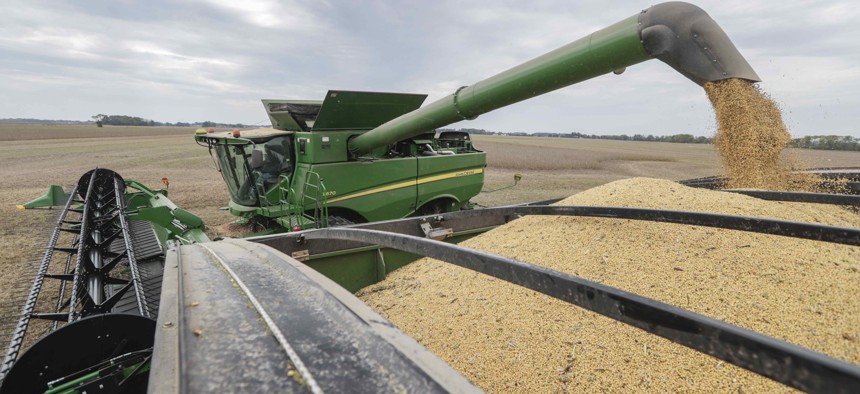The Soybean-Producing States at Risk in the Trade War With China

Mike Starkey offloads soybeans from his combine as he harvests his crops in Brownsburg, Ind., Friday, Sept. 21, 2018. AP Photo/Michael Conroy
Much of the nation’s exported soybeans went to China last year. Production is concentrated in a handful of states.
The risks that America’s top soybean-producing states face in the trade war between the U.S. and China are underscored in recent research from the Federal Reserve Bank of St. Louis.
Researchers there say the nation’s top exports last year to China, in dollar terms, included civilian aircraft ($16.2 billion), soybeans ($12.2 billion) and motor vehicles ($10.3 billion).
But passenger aircraft for now aren’t subject to retaliatory tariffs and the researchers note that there’s a large market here in the U.S. and in countries other than China for cars and trucks.
That leaves soybeans. The article from the St. Louis Fed points out that the nation’s top 10 soybean-producing states account for 79 percent of American soybean production.
At the top of the list is Illinois, which produces about 14 percent of the nation’s soybeans and Iowa, which grows about 13 percent. Those states are trailed by Minnesota, Indiana, Nebraska and Missouri.
The value of soybean exports to China rose from around 19 percent of U.S. soybean exports in 2001 to around 57 percent in 2017, the article says. Motor vehicle exports to China increased from around 0.08 percent to around 19 percent of U.S. auto exports during that time. Aircraft exports to China went from near zero to 13 percent.
Washington and California are top states for aerospace manufacturing. And Michigan and Indiana for motor vehicles.
Soybeans and vehicles are among the products China has targeted with tariffs, since the Trump administration moved ahead with plans to impose tariffs on Chinese goods earlier this year.
U.S. soybean exports surged in May as the U.S. tariffs loomed. But they fell in July, compared to June, according to the most recent available figures from the U.S. Census Bureau.
The U.S. Department of Agriculture announced in July it would authorize up to $12 billion in assistance for farmers affected by retaliatory trade measures. Soybeans are one of the products that qualifies for aid. Sorghum, wheat, cotton, corn and hogs are among the others.
A full copy of the Federal Reserve Bank of St. Louis article, which appears in the latest quarterly edition of Regional Economist can be found here.
Bill Lucia is a Senior Reporter for Government Executive's Route Fifty and is based in Washington, D.C.
NEXT STORY: The Best Way to Bring a State or Local Public Corruption Tip to the FBI’s Attention






